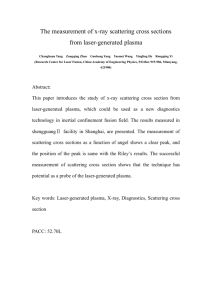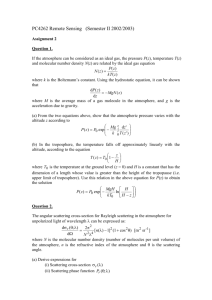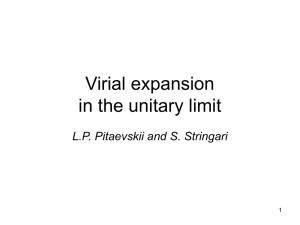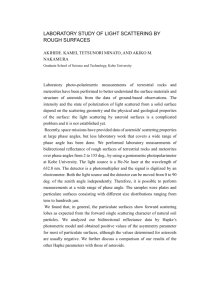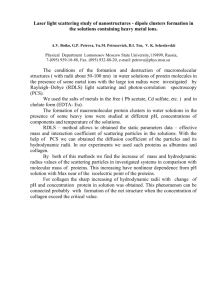Thermal-Neutron Scattering (Draft, 2015-11-01)
advertisement
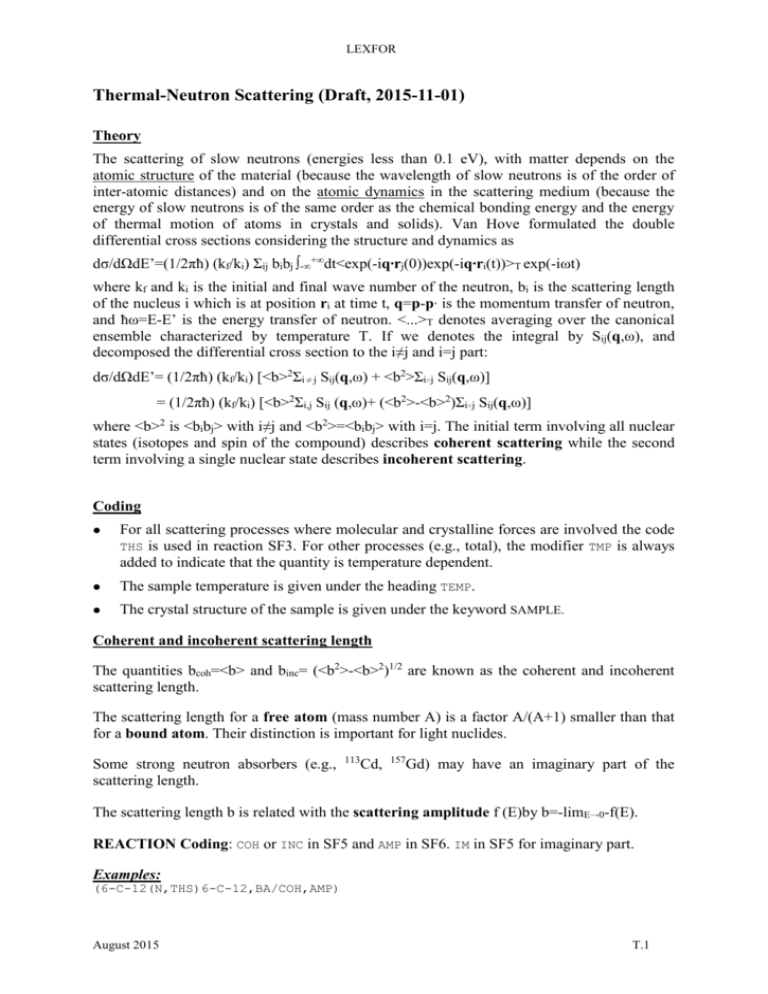
LEXFOR Thermal-Neutron Scattering (Draft, 2015-11-01) Theory The scattering of slow neutrons (energies less than 0.1 eV), with matter depends on the atomic structure of the material (because the wavelength of slow neutrons is of the order of inter-atomic distances) and on the atomic dynamics in the scattering medium (because the energy of slow neutrons is of the same order as the chemical bonding energy and the energy of thermal motion of atoms in crystals and solids). Van Hove formulated the double differential cross sections considering the structure and dynamics as dσ/dΩdE’=(1/2πħ) (kf/ki) Σij bibj ∫-∞+∞dt<exp(-iq∙rj(0))exp(-iq∙ri(t))>T exp(-iωt) where kf and ki is the initial and final wave number of the neutron, bi is the scattering length of the nucleus i which is at position ri at time t, q=p-p’ is the momentum transfer of neutron, and ħω=E-E’ is the energy transfer of neutron. <...>T denotes averaging over the canonical ensemble characterized by temperature T. If we denotes the integral by Sij(q,ω), and decomposed the differential cross section to the i≠j and i=j part: dσ/dΩdE’= (1/2πħ) (kf/ki) [<b>2Σi≠j Sij(q,ω) + <b2>Σi=j Sij(q,ω)] = (1/2πħ) (kf/ki) [<b>2Σi,j Sij (q,ω)+ (<b2>-<b>2)Σi=j Sij(q,ω)] where <b>2 is <bibj> with i≠j and <b2>=<bibj> with i=j. The initial term involving all nuclear states (isotopes and spin of the compound) describes coherent scattering while the second term involving a single nuclear state describes incoherent scattering. Coding For all scattering processes where molecular and crystalline forces are involved the code THS is used in reaction SF3. For other processes (e.g., total), the modifier TMP is always added to indicate that the quantity is temperature dependent. The sample temperature is given under the heading TEMP. The crystal structure of the sample is given under the keyword SAMPLE. Coherent and incoherent scattering length The quantities bcoh=<b> and binc= (<b2>-<b>2)1/2 are known as the coherent and incoherent scattering length. The scattering length for a free atom (mass number A) is a factor A/(A+1) smaller than that for a bound atom. Their distinction is important for light nuclides. Some strong neutron absorbers (e.g., scattering length. 113 Cd, 157 Gd) may have an imaginary part of the The scattering length b is related with the scattering amplitude f (E)by b=-limE→0-f(E). REACTION Coding: COH or INC in SF5 and AMP in SF6. IM in SF5 for imaginary part. Examples: (6-C-12(N,THS)6-C-12,BA/COH,AMP) August 2015 T.1 LEXFOR Bound atom coherent scattering length of 12C (23-V-51(N,THS)23-V-51,FA/INC,AMP) Free atom incoherent scattering length of 51V (64-GD-157(N,THS)64-GD-157,COH/IM,AMP) Imaginary part of coherent scattering length of 157Gd Contribution of potential scattering and resonance scattering The bound atom scattering length is the sum of the contribution from potential scattering and all s-wave resonances: [A/(A+1)]b± = R’ – [(A+1)/A] [ħ/(8m)1/2] Σi± [(Γn,i/E0,i3/2) – i (Γn,iΓn/2E0,i5/2)], where m is the neutron mass and ħc/(8m)1/2~2277 fm eV1/2. R’ is the potential scattering radius, A is the mass number of the nuclei, Γn,i and Γi are the neutron and total width of the ith resonance at the resonance energy E0,i. Σ± means summation for all resonance having the same spin J+=I+1/2 or J+=I-1/2. Their weighted mean gives <b>=g+b++g-b- with g±=[2(I±1/2)+1]/[(2J+1)2]. Note that only J=I+1/2 is possible for spin zero nuclei, and bcoh=b+ and binc=0 for them. For example, thorium gives no incoherent scattering because it is enriched to thorium-232 and its ground state spin is zero. The imaginary part of <b> is related with the absorption cross section by Im(<b>)=kσabs(E)/4π (optical theorem) at E→0. Coherent and incoherent cross section The quantities σcoh=4πbcoh2 and σinc=4πbinc2 are known as the coherent and incoherent scattering cross section. Their values for bound and free atom are related by the factor A/(A+1). Their sum 4π(bcoh2+binc2) gives the total scattering cross section at zero energy. Examples: (6-C-12(N,THS)6-C-12,BA/COH,SIG) Bound atom coherent cross section of 12C (23-V-51(N,THS)23-V-51,INC,SIG) Incoherent cross section of 51V References [1.] S. Mughabghab, Atlas of neutron resonances: Resonance parameters and thermal cross sections Z=1-100 (Elsevier, 2006). [2.] B.T.M. Willis and C.J.Carlile, Experimental neutron scattering (Oxford University Press, London, 2009). T.2 August 2015




